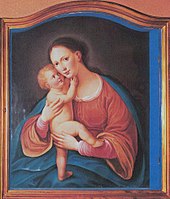Rumburk City Museum
The Rumburk City Museum is located in the city of Rumburk in the former Förster factory for dyeing fabrics and linen. It is a branch of the Regional Museum in Děčín .
history
The museum was founded in 1902 by members of the Humboldt Society through a decision by the city council as a small local history museum and was located in the rooms of the textile school at the time. The museum's collections originally focused on depicting the development and manufacture of textiles and the documentation of linen production. The collections were built up by the school's employed teachers. In 1920 Professor Lerchl took over the management, followed by Dr. Erwin Görlach. Rudolf Demel headed the museum from 1936 to 1974. From 1938 to 1945 some collections in the Rumburg Castle, in the Capuchin Monastery and in the Pfeifer factory were relocated. After the war, the museum's collections were saved.
From September 1945 Rudolf Demel and Prof. Stanislav Gaber rebuilt the collections in the former Förster factory. The collections were greatly enriched by the confiscation. The museum took over the collections of the former museum in Krásná Lípa (Schönlinde) and the collection of the private collector Friese from Jiřetín pod Jedlovou (Sankt Georgenthal). The new exhibition was opened to the public on July 4, 1949. At the beginning of the 1950s the valuable books from the libraries of the dissolved monasteries (Capuchin monastery Rumburk, Redemptorist monastery Filipov (Philippsdorf) and Oblate monastery Varnsdorf ) were stored here. An archive was established in 1951, which existed until the Rumburk district was dissolved in 1960. Between 1974 and 1985, PhDr. Vojtěch Čelko the museum, then Mgr. Irena Borovcová and Zdeněk Jemelka and from 1994 to 2006 Barbora Hildebrandtová.
Collections
After the renovation of the building in 1995–1998 and 2008/09, the collections were redesigned from 2011 onwards. There is a permanent exhibition for visitors on the following topics:
- Presentation of the history of Rumburg / Rumburk and its surroundings
- History of Tollenstein Castle (Tolštejn)
- Representation of local personalities, e.g. B. the Münzbergs at Tollenstein Castle:
- Johann Josef Münzberg (1838–1907)
- Johann Ferdinand Karl Münzberg II. (1868–1925)
- Johann Franz Münzberg III. (1892–1977)
- Rumburg military uprising of May 1918
- Meissen porcelain from the 19th century.
- Tin and the manufacture of metal keys by Tyssa Technology as in Šluknov (Schluckenau)
- Memories of the pianist and composer August Stradal (1860–1930), the last student of Franz Liszt , with the restored clavichord from the first half of the 18th century from his estate
- Studio and pictures of the academic painter August Frind (1852–1924)
- Exhibition of nativity scenes from the region, mostly on motifs of the Nazarene Joseph von Führich were designed
Web links
Individual evidence
- ^ Museum Rumburk (Czech) (accessed on September 16, 2017)
- ↑ From the History of the Museum (Czech) (accessed May 15, 2019)
- ^ Museum Rumburk (Czech) (accessed on September 16, 2017)
- ↑ Lenka Kopáčková: Muzeum Rumburk od roku 1881 po současnost. 2013, 55 pp. - Bachelor thesis at the Jan Evangelista Purkyně University Ústí nad Labem (Czech) (accessed on September 16, 2017)
- ↑ Hartmut Schütz: Cribs, Art and War. In: DNN . No. 25, January 30, 2018, p. 8.
Coordinates: 50 ° 56 ′ 59.8 ″ N , 14 ° 33 ′ 27.6 ″ E

